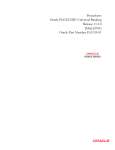Download Charge and Fees User Manual
Transcript
Charges and Fees Oracle FLEXCUBE Universal Banking Release 11.6.0.0.0 [October] [2015] Charges and Fees Table of Content 1. ABOUT THIS MANUAL................................................................................................................................ 1-1 1.1 1.2 1.3 1.4 1.5 1.6 2. INTRODUCTION ........................................................................................................................................... 1-1 AUDIENCE .................................................................................................................................................. 1-1 ORGANIZATION .......................................................................................................................................... 1-1 CONVENTIONS USED IN THIS MANUAL ....................................................................................................... 1-1 GLOSSARY OF ICONS .................................................................................................................................. 1-1 RELATED DOCUMENTS ............................................................................................................................... 1-2 PROCESSING CHARGES............................................................................................................................. 2-1 2.1 INTRODUCTION ........................................................................................................................................... 2-1 2.1.1 Steps involved in processing charges................................................................................................. 2-2 2.2 CREATING CHARGE RULES ......................................................................................................................... 2-2 2.2.1 Building Charge Rule ........................................................................................................................ 2-4 2.2.2 Sequence for Resolution of ICCF Rules ........................................................................................... 2-14 2.2.3 Copying an ICCF Rule .................................................................................................................... 2-14 2.2.4 Defining charge rule application conditions ................................................................................... 2-15 2.2.5 Defining a Charge Class.................................................................................................................. 2-16 2.2.6 Defining Charge Components for a Product ................................................................................... 2-22 2.2.7 Indicating whether Advice Processing Charges need to be collected.............................................. 2-23 2.2.8 Associating a charge class with a product....................................................................................... 2-23 2.2.9 Associating several charge classes with a product .......................................................................... 2-23 2.2.10 Contract Charge Details .................................................................................................................. 2-24 2.2.11 Indicating whether Advice Processing Charges need to be collected.............................................. 2-27 2.2.12 Levying charges on the recipient of a message................................................................................ 2-28 1. About this Manual 1.1 Introduction This manual is designed to help you get acquainted with the manner in which charges or fees are calculated in Oracle FLEXCUBE. It takes you through the various steps involved in processing a Charge or Fee for a contract. Besides this User Manual, you can find answers to specific features and procedures in the Online Help, which can be invoked, by choosing ‘Help Contents’ from the Help Menu of the software. You can further obtain information specific to a particular field by placing the cursor on the relevant field and striking <F1> on the keyboard. 1.2 Audience This manual is intended for the following User/User Roles: 1.3 1.4 Role Function Back office clerk Input functions for contracts Back office managers/officers Authorization functions Product Managers Product definition and authorization End of day operators Processing during end of day/ beginning of day Financial Controller / Product Managers Generation of reports Organization Chapter 1 About this Manual gives a brief introduction to the module. It also lists the various chapters in the User Manual. Chapter 2 Processing Charges details the procedure to set up Charge or Fee details by defining Charge rules and Charge classes. It also explains the procedure for specifying charge details for a contract. Conventions Used in this Manual Important information is preceded with the 1.5 symbol. Glossary of Icons This User Manual may refer to all or some of the following icons. Icons Function 1-1 Icons Function Exit Add row Delete row Option List 1.6 Related Documents For further information on procedures discussed in the manual, refer to the Oracle FLEXCUBE manual on Products. 1-2 2. Processing Charges 2.1 Introduction A charge or fee is a payment that you levy on your customer in exchange for advices or services rendered by your bank. Banks charge nominal fees for various services, such as courier charges, SWIFT charges. Bank charges generally constitute a major portion of revenue for the bank. These type of charges are associated with al most all the activities of the bank. For instance, when a bank accepts corporate deposits, it may also recover pre-closure charges or pre-payment penalty on the deposit. Apart from charges, bank collects fees also. For example, if there are any legal proceedings for any reason, banks will debit the fees associated with this to the customer. While setting up a product in Oracle FLEXCUBE, attributes for charge/fees collection also have to be set up. In Oracle FLEXCUBE, you can define the different types of charges or fees that apply on a product as ‘classes’. A charge class is a specific type of charge component (E.g. ‘Charges for amending the terms of a contract’). A charge class is like a template, which can be associated with a product. You can modify certain parameters of the charge class while associating it with a product and also at the time of contract processing. When defining a product, you merely have to attach the required classes. In this manner, a contract processed under a particular product acquires the classes (components) associated with the product. However for Funds Transfer and Foreign Exchange modules, Oracle FLEXCUBE will not use charge classes for calculating charges. You need to link a charge rule while defining the charge component for the product. The linking of a charge rule to a product is discussed in the subsequent sections of this chapter. To apply a charge or fee on a Funds Transfer, you should first define attributes for each of the components. You can define these attributes by specifying a Rule for the charge or fee. These charge rules should in turn be linked to a product through a class, so that the attributes of the charge rule will be applied on all contracts linked to the product. However, while capturing the details of a contract, you can modify some of the attributes defined for a rule. Further, for a contract, you can also indicate whether the application of a specific charge component should be waived. You cannot modify the attributes of the rule during contract input. However, you can change the charge amount. More than one charge or fee can be applied on a product. For example, you could link two charges to an outgoing transfer product, one with 0.05% of the transfer amount as the charge and another with a flat amount of say 200 local currency units. The first one could be your commission on the transfer and the second, for the SWIFT or cable charges incurred to affect the transfer. These will be processed as two different charge components. The income accounts can be different for these components. The two charge components will be reported in all reports and in the customer correspondence regarding the transfer. 2-1 2.1.1 Steps involved in processing charges The following steps are involved in processing charges: 1. Defining branch restriction for ICCF rule 2. Maintaining ICCF rule availability - Branch Specific Rules 3. Defining charge rules and attributes - When you define a rule, you can also restrict the use of the rule for the different branches of the bank. 4. Defining charge class 5. Link a charge class to a product 6. Specify charge details for a contract 2.2 Creating Charge Rules A charge rule is created as under: • The rule is created at the head office branch, by giving it a unique identification and description, in the ‘ICCF Rule Branch Availability Maintenance’ screen. In this screen, the rule is made available for use in the required branches by maintaining an allowed/disallowed list of branches. • At the required branch, in the ‘ICCF Rule Details’ screen, the attributes for the rule are defined. Maintaining the attributes in this screen is subject to whether maintenance of ICCF rules is allowed for the branch, and also whether the rule for which attributes are being defined, is allowed for the branch. To recall, at the head office of your branch, you can create appropriate ICCF rules and make the rules available to the required branches. In the ‘ICCF Rule Availability Maintenance’ screen, you can maintain ICCF rules, which you can make available to desired branches. You can do this by maintaining a list of branches for which the use of the rule is allowed, or disallowed. You can invoke this screen by typing ‘CFDICCFR’ in the field at the top right corner of the Application tool bar and clicking the adjoining arrow button. 2-2 In this screen, you must specify the following information: Rule ID and Description You must specify a unique identification for the ICCF rule you are creating. If you are creating a charge rule, specify a unique identification for the charge rule. This is the identification that will be used as to identify for the rule, in all subsequent references to it. You must also specify a unique description for the rule. Every charge rule is identified by a unique ten-character code, called a Rule ID. You can link a valid Charge Rule ID to the charge classes that you maintain in your bank. Charges or fees for all products with which you associate a charge class, will be calculated on the basis of the Rule ID that is associated with the class. You must select the Rule ID to have all the bank branches listed in the Branch field list of options. After the rule has been created, the attributes for the rule must be defined in the ‘ICCF Rule Details’ screen. Branch Restrictions You can maintain a list of allowed branches (that is, the rule will be available for use in the allowed list of branches) or disallowed branches (the rule will not be available for use in the branches in the disallowed list). To recall, the attributes for the rule are defined, in the ICCF Rule Maintenance screen. Maintaining the attributes in this screen, for a branch, is subject to whether maintenance of ICCF rules is allowed for the branch, and also whether the rule for which attributes are being defined, is allowed for the branch. 2-3 For details about the Common Branch Restrictions, refer the Security Management System user manual. Example You have created the following Common Branch Restrictions: Home Branch Restriction Type Allowed Branches 000 ICCFRULE 000, 001, 002, 005 001 ICCFRULE 001, 006 The administrator of branch 000 can create, modify and delete ICCF rules in the branches 000, 001, 002 and 005, but not for 006. The administrator of Branch 001 can create, modify and delete ICCF rules in the branches 001 and 006 only. 2.2.1 Building Charge Rule To recall, after a charge rule has been created in the ‘ICCF Rule Availability Maintenance’ screen, the attributes for the rule must be defined in the ‘ICCF Rule Maintenance’ screen. A charge rule is built with the logic to calculate a specific type of charge component. You can maintain this logic in the ‘ICCF Rule Maintenance’ screen. You can invoke this screen by typing ‘CFDRUMNT’ in the field at the top right corner of the Application tool bar and clicking the adjoining arrow button. If you are defining a charge rule, select ‘New’ from the Actions Menu in the Application toolbar or click new icon. The ‘ICCF Rule Maintenance’ screen is displayed without any details. If you are calling a charge rule that has already been defined, double-click a rule of your choice from the summary screen. 2-4 You can capture the following details. Rule Type The Rule Type identifies the type of component you are defining. The attributes applicable for a component depend on the Rule Type. In this chapter, we shall discuss the procedure for setting up rules for charge components. For every rule that you define, you can enter a description. Specifying a description helps identify a rule. Rule Identification Every charge rule is identified by a unique ten-character code, called a Rule ID. You can link a valid Charge Rule ID to the charge classes that you maintain in your bank. Charges or fees for all products with which you associate a charge class, will be calculated on the basis of the Rule ID that is associated with the class. To recall, the Rule ID for a charge rule is specified in the ICCF Rule Branch Availability maintenance. Accordingly, in the Rule ID field in this screen, you must select the ID of the charge rule that you wish to build by maintaining the attributes. The option list in the Rule ID field is populated based on the following conditions: • Only those Rule IDs that are available for users at the current branch according to the ICCF Rule Branch Availability maintenance are displayed • The maintenance of ICCF rules must be allowed for users at the current branch, according to the restrictions maintained in the Common Branch Restrictions maintenance for the restriction type ICCFRULE. If no Common Branch Restrictions have been maintained, and the restriction type ICCFRULE has not been maintained in the SMS Branch Restriction Type maintenance, the option list in the Rule ID field only displays those rules that are available for users in the current branch, according to the ICCF Rule Branch Availability maintenance. 2.2.1.1 Rule Application Conditions By default, a charge rule that you define can be applied on transactions in • All currencies • All customers • All customer groups • All branches However, to restrict the application of a rule to transactions involving a specific customer, customer group, currency, and / or branch, you can specify the same in the respective fields. Thus, the most generally applied condition can be that a charge rule is applicable to contracts in any currency, involving any customer, customer group or branch. An interim condition is that a charge rule is applied on contracts in a specific currency but involving any customer, customer group or branch. 2-5 Example Requirement: You would like to levy a special flat charge, in EUR, for processing withdrawals for a particular customer in Pound - EUR being the more convenient currency. Set up: Step 1 To the rule defined for calculating the special charge, assign a unique Rule ID, SplWDCHGS. Briefly describe the charge for easy identification: EUR charge: Withdrawals. Step 2 Choose the Flat Amount option in the Rate Type field. Step 3 Choose EUR in the Currency field. Since you want to levy this charge on a specific customer, indicate the CIF Id of the customer. Step 4 Save this record. Another user with the requisite rights should authorize this record before it can be used. You will not be allowed to define an ICCF Rule for a specific combination unless you maintain a record for the same Rule at the generic level. For instance, while creating the Rule ID SPlWDCHGS for the very first time the system defaults the values in the Transaction Currency, Branch, Account Category, Customer, Customer Group, Branch and Account fields to ‘All’. Only after saving this record you will be allowed to create a second record for a specific combination for the same Rule ID. Defining a rule at a generic level is mandatory. The significance of this can be understood by the following example: A rule ‘MMCH’ which was created for a specific customer category ‘FBANK’ (Foreign Bank) was attached to a Money Market Product ‘MMFB’. The charges defined in this rule were very specific and special to the Foreign Bank Money Market Deals. The Money Market contracts were created by using this Product. Bank decided not to offer the special charges for the Foreign Bank Money Market Deals. The Rule which had customer category as ‘FBANK’ is closed. Since this rule was attached to contracts, the accounting entries get generated as per the generic rule and not as per the rule which was defined for ‘FBANK’ Category Customers. If the rule was not maintained at a generic level, the charge collection at the contract level would have failed. Hence defining a rule at a generic level is made mandatory. You can only define the attributes for an ICCF Rule to be applicable for all branches, from the head office branch. You can create ICCF rules to be applicable for transactions with the following specific combinations: • A specific branch, customer category, customer and currency • A specific branch, customer category, customer and all currencies • A specific branch, customer category, currency and all customers • A specific branch, currency and all customer categories and customers • A specific branch, customer categories and all currencies and customers • A specific branch and all customer categories, customers and currencies • A specific customer category, customer, currency, and all branches • A specific customer category, customer and all currencies and branches 2-6 • A specific customer category, currency and all customers and branches • A specific currency and all customer categories, customers and branches • A specific customer category and all customers, currencies and branches • All branches, customer categories, customers and currencies As mentioned earlier, the rules applicable for combinations involving all branches (the ALL option in the Branch Code field) can be maintained only from the head office branch. Transaction Currency If you wish to define the attributes for all currencies, you can select the ALL option in the Currency Code field to indicate this. If you are maintaining the attributes for the selected ICCF rule in specific currency other than the ALL, select the Transaction Currency on which the rule mapping maintenance is to be made applicable. Customer Group Select the customer group on which the rule mapping maintenance is to be made applicable. You can create a generalized charge rule mapping record by selecting the ALL option in the Customer Group field. This specification is defaulted to the Customer and Customer Account fields. You will not be allowed to change the specification. Customer Specify the customer identification number (CIF) of the customer for whom you are maintaining the rule mapping. Branch Code If you are maintaining the attributes for the selected ICCF rule from the head office branch, you can select the branch for which the attributes are being defined. If you wish to define the attributes for all branches, you can select the ALL option in the Branch Code field to indicate this. If you are maintaining the attributes for the selected ICCF rule from a branch other than the head office, you can only select those branches that are found in the allowed list of branches for: • the ICCF rule definition Restriction Type (ICCFRULE), in the Common Branch Restrictions maintenance for the current branch • the selected rule being built, according to the ICCF Rule Availability maintenance In other words, the option list in the Branch Code field would display only those branches that are allowed both for the rule and the current branch. 2-7 The following example illustrates how the option lists in the Rule ID and Branch Code fields are populated: Example You have created the following Common Branch Restrictions for the restriction type ICCFRULE: Home Branch Allowed Branches 000 000, 001, 002, 005 001 001, 006 002 002, 005, 006 005 002, 005, 006 You have maintained the following rules in the ICCF Rule Branch Availability Maintenance: RULE ID Allowed Branches CHRULE1 000, 001, 002, 005, 006 CHRULE2 001, 005, 006 CHRULE3 002, 005,006 In the ICCF Rule Details screen, the following options would result if the maintenance were as mentioned above: Branch Rule ID field option list Branch Code option list 000 CHRULE1 000, 001, 002, 005 001 CHRULE1, CHRULE2 001, 006 002 CHRULE1, CHRULE3 002, 005, 006 005 CHRULE1, CHRULE2, CHRULE3 002, 005, 006 (for CHRULE1), 005, 006 (for CHRULE2) or 002, 005, 006 (for CHRULE3) If no Common Branch Restrictions were maintained, and the restriction type ICCFRULE was not maintained in the SMS Branch Restriction Type maintenance, the options in the ICCF Rule Details screen would be as follows: Branch Rule ID field option list Branch Code option list 000 CHRULE1 000, 001, 002, 005, 006 001 CHRULE1, CHRULE2 000, 001, 002, 005, 006 (for CHRULE1) or 001, 005, 006 (for CHRULE2) 002 CHRULE1, CHRULE3 000, 001, 002, 005, 006 (for CHRULE1) or 002, 005, 006 (for CHRULE3) 2-8 Branch Rule ID field option list Branch Code option list 005 CHRULE1, CHRULE2, CHRULE3 000, 001, 002, 005, 006 (for CHRULE1), 001, 005, 006 (for CHRULE2) or 002, 005, 006 (for CHRULE3) Rate Type The rate type indicates whether the charge or fee to be applied for the Rule ID is a flat amount or a percentage of the basis amount. Basis amount here refers to: • Principal amount or commitment • Transaction amount in the case of a teller entry • Transfer amount in case of a Remittance • SI Amount in case of Standing Instruction • LC amount in the case of a Letter of Credit • Bill amount in the case of a Bill • Buy/Sell amount in the case of an FX deal • Deal Nominal amount for a Security Deal If the Charge Rule that you are defining calculates charges on a rate basis, choose the Fixed Rate option. To levy a flat amount as charge, say a postal charge on the products that are associated with the Charge Class, choose the ‘Flat Amount’ option. You can choose to indicate the Rate Code and whether the rate is Mid, Buy or Sell only when the basis amount currency and the rate currency is different from the contract currency. The rate code is used to arrive at the exchange rate if the rate currency is different from the contract currency. The system arrives at the exchange rate from the parameters specified for the currency pair in the Currency Pair Definition table. If the charge is based on the Flat Amount, 'Min Amount' and 'Max Amount' are not applicable. Refer to the chapter on ‘Currency Maintenance’ in the Core Services User Manual for more information on parameters of currency pairs. Tenor Basis You can create a charge rule that would calculate charges on the basis of Tenor slabs. Check the ‘Tenor Basis’ check box if the Charge is calculated based on the Tenor. Example You have defined a Charge Rule, ‘SPLPRC’, to collect the money market deal processing charge which you would like to apply on the deal amount, with the following Tenor Basis structure: Tenor Rate 0 to 365 0.05% 366 to 1095 0.06% 1096 to 999999 0.07% This rule is applied on the deal amount of 1.5 Million USD, where the tenor of the deal is 730 days, the charge amount is calculated depending on the tenor of the deal. 730 days falls in the second slab i.e. 366 to 1095, the Charge Rate for this slab is 0.06%. Hence 0.06% is calculated on 1.5 Million USD, Charge amount = (1500000*730*0.06)/(365*100). The Charge Amount works out to USD 1800. 2-9 Tiered Tenor Charges calculated on the basis of Charge Rates for different layers of the Tenor. Example You have defined a Charge Rule, ‘SPLPRC’, to collect the commitment charge which you would like to apply on the commitment amount, with the following Tiered Tenor Basis structure: Tenor Rate 0 to 365 0.05% 366 to 1095 0.06% 1096 to 999999 0.07% When this rule is applied on a commitment amount of 1.5 Million USD, where the tenor of the commitment is 800 days, the charge amount is calculated depending on the tenor of the commitment. In 730 days, the first 365 days attracts 0.05% , the residual 435 days attracts 0.06%. Step 1 0.05% is calculated on 1.5 Million USD for 365 days. Charge amount = (1500000*365*0.05)/(365*100). The Charge Amount works out to USD 750. Step 2 0.06% is calculated on 1.5 Million USD for 435 days. Charge amount = (1500000*435*0.06)/(365*100). The Charge Amount works out to USD 1072.60. Total Charge amount = Step 1 + Step 2 = USD 750 + USD 1072.60 = USD 1822.60 2.2.1.2 Basis Amount and the Charge Currencies The charge currency is the currency, which will be associated with the charge that is calculated or the flat charge amount. When building a charge rule, if the Rate Type is a Flat Amount, you have to indicate the currency of the charge or fee. The charge or fee when applied on a transaction will be collected in this currency. The input to this field can be any currency that is maintained as part of Currency Definition in Oracle FLEXCUBE. The amount itself is specified subsequently through this screen. This amount can be changed during contract processing. Example If the Charge Currency is specified as the local currency and the flat amount is 500, for all contracts involving this Rule ID, an amount of LCY 500 will be applied. If the Charge Currency is specified as the contract currency and the flat amount is 1000; for a bill in US Dollar involving this Rule ID, an amount of USD 1000 will be applied, for a contract in GBP involving this Rule ID, an amount of GBP 1000 will be applied, and so on. Charges or fees can be calculated for a transaction on the basis of tiers or slabs. When building a charge rule, you should also indicate the currency of the tiers or slabs based on which you levy the charge. This is the Basis Amount Currency. If the transaction is in a different currency, then the charge is calculated after converting it to the currency of the tiers and slabs. 2.2.1.3 Maximum and Minimum Charge Amount Specify the following details. 2-10 Maximum Amount If the charge is based on a fixed rate, you should specify the maximum amount that can be applied on a contract involving the Rule ID. If the charge calculated using this Rule ID exceeds this amount for a contract, the maximum amount specified in this field will be applied instead of the amount calculated using the fixed rate. Maximum Rate If the charge is based on a fixed rate, you should specify the maximum rate that can be applied on a contract involving the Rule ID. If the charge calculated using this Rule ID falls above the amount which is computed using the maximum rate defined in the rule, then the amount which is computed using the maximum rate will be collected. Minimum Amount If the charge is based on a fixed rate, you should specify the minimum amount that can be applied on a contract involving the Rule ID. If the charge calculated using this Rule ID falls below this amount for a contract, the minimum amount specified in this field will be applied instead of the amount calculated using the fixed rate. Minimum Rate If the charge is based on a fixed rate, you should specify the minimum rate that can be applied on a contract involving the Rule ID. If the charge calculated using this Rule ID falls below the amount which is computed using the minimum rate defined in the rule, then the amount which is computed using the minimum rate will be collected. Maximum Rate If the charge is based on a fixed rate, you should specify the maximum rate that can be applied on a contract involving the Rule ID. If the charge calculated using this Rule ID falls above the amount which is computed using the maximum rate defined in the rule, then the amount which is computed using the maximum rate will be collected. Tiered Amount You can create a Charge Rule that would calculate charges on the basis of an amount structure. This structure could be in tiers or in slabs. Check against ‘Tiered Amount’ if the Basis Amount structure will be Tiers. Leave it blank if the Basis Amount structure is Slab. The following example illustrates how this works: Example You have defined a Charge Rule, SplWDCHGS, which you would like to apply on withdrawals in USD, with the following amount basis structure: Amount Rate 0 to 250 Thousand 0.05% > 250 Thousand <= 1 Million 0.06% > 1 Million <= 3 Million 0.07% > 3 Million 0.08% 2-11 When this rule is applied on a withdrawal of 1.5 Million USD, the rate of the charge will be calculated depending on whether the basis has been defined as Slab or Tier as indicated below. Tier basis The first 250,000 (of the total value of 1.5 million) will be charged at 0.05% The amount from 250,000 to 1,000,000 at 0.06% The amount from 1,000,000 to 1,500,000 at 0.07% The total amount levied as charge will be USD 925. Slab basis The entire USD 1.5 million will be charged at 0.07% Therefore, the amount charged will be USD 1,050. Bracket Tenor You can create a Charge Rule which calculates charges on the basis of an amount structure. In this table you define the different attributes of amount structure based on which the charges are calculated. Basis Amount To You should specify the upper limit of the slab or tier to which a particular rate or amount should be applied as a charge. Example Suppose the following is the slab or tier structure you want to specify: Amount Rate 0 to 250 thousand 0.05% > 250 thousand <= 1 Million 0.06% > 1 Million <= 3 Million 0.07% > 3 Million 0.08% The Basis Amount To for the first slab or tier should be indicated as 250,000; for the second slab or tier as 1,000,000 and so on. Fixed Rate If the charge is a percentage of an amount, specify the applicable rate. This rate will be applied on the Basis Amount To, depending on whether you have defined the application basis, as a slab or a tier. Charge Unit The Charge Unit specifies the unit for rounding up a charge basis amount or fee basis amount to the nearest amount. The charge or fee will be calculated on the rounded basis amount. Example If the Charge Unit has been specified as 10 and the charge is to be calculated for USD 85, then the charge will be calculated for the rounded up figure of USD 90. Similarly if the Charge Unit has been specified as 100 and the charge is to be calculated for USD 750; the charge will be calculated for the rounded up figure of USD 800. 2-12 Flat (CCF) Amount To levy a flat charge, specify the flat amount. This amount will be applied on the Basis Amount, depending on whether you have defined the application basis as a slab or a tier. Floor Basis Amount You should specify this only if the Amount Basis is a Tier. This will be the upper limit of the previous tier limit. By default, the amount specified as the ‘Basis Amount To’ for the previous tier limit will be displayed. For the first limit in the tier do not specify this. This amount, along with the Floor CCF Amount, is used to calculate the charge. An example for calculating charges based on tiers For a specific type of transaction, the charges are applied based on the following structure: > 0 <= 10,000 0.05% > 10,000 <= 20,000 0.06% > 20,000 0.08% The following will be the specifications in the ICCF Rule Details screen: Basis Amount Fixed Rate Floor Basis Amount 10000 (upper limit of the first tier) 0.05 0 20000 0.06 10000 (upper limit of the first tier) 999999999 (a big amount, since there is no upper limit for the third slab) 0.08 20000 (upper limit of the second tier) When a transaction is processed under the product to which you attach the Charge Class (consisting of the Rule you are building), the calculation of charges will be as follows, depending on the transaction amount: If the transaction amount is USD 5000, it falls in the first tier. The charge amount will be calculated in the following manner: Transaction amount = USD 5,000 Charge amount 0.05% of USD 5,000 = 2.5 If the transaction amount is USD 15,000, it falls in the second tier. The charge amount will be calculated in the following manner: Transaction Amount = USD 15000 Of this amount, USD 10000 attracts 0.05% which amounts to USD 5 and residual USD 5000 attracts 0.06% which amounts to USD 3. Charge Amount = USD 3 + 5 = USD 8 If the Transaction amount is USD 30000, it falls in the third slab. The charge amount will be calculated in the following manner: Transaction Amount = USD 30000 2-13 Of this amount, the first slab of USD 10000 attracts 0.05% which amounts to USD 5. The next slab of USD 10000 attracts 0.06% which amounts to USD 6. Residual USD 10000 attracts 0.08% which amounts to USD 8. Charge Amount = USD 5+6+8 = USD 19 Floor CCF Amount You should specify this only if the Rule Type is a Commission. Tenor Details – Tenor From and Tenor To The tenor is in days. For instance, If Tenor from and Tenor to are given as '0' and 91, the tenor slab is from '0' days to '91' days. 2.2.2 Sequence for Resolution of ICCF Rules ICCF Rules that you maintain are resolved in the following sequence: Rule Branch Customer Category Customer Currency Specific Specific Specific Specific Specific Specific Specific Specific Specific ALL Specific Specific Specific ALL Specific Specific Specific ALL ALL Specific Specific Specific Specific ALL ALL Specific Specific ALL ALL ALL Specific ALL Specific Specific Specific Specific ALL Specific Specific ALL Specific ALL Specific ALL Specific Specific ALL ALL ALL Specific Specific ALL Specific ALL ALL Specific ALL ALL ALL ALL 2.2.3 Copying an ICCF Rule In order to make the definition of ICCF rules easier, you can copy an existing rule and modify its attributes. You can do this through the ‘ICCF Rule Copy’ screen. To invoke this screen, select an existing record and click copy icon or select ‘Copy’ from the Actions menu in the Application toolbar. 2-14 In this screen, you must indicate the combination for your search. The options are: • Rule Identification • Transaction Currency • Customer Group • Customer • Branch Code A list of all rules defined for the combination you have specified is displayed. You can select the appropriate rule. 2.2.4 Defining charge rule application conditions When you have built charge rules, you are ready to build Charge Classes. When creating a product, you can link it with a Charge Class you have built. Thus, the definition of charge rules should precede the definition of Charge Classes and Product Definition. 2-15 2.2.5 Defining a Charge Class A class is a specific type of component that you can build with certain attributes. You can build a charge class, for instance, with the attributes of a specific type of charge, such as ‘Charges for amending the terms of a transaction’, or ‘Charges for provision of services’. To recall, a charge rule is built to calculate a specific type of charge component. Once such a rule is built, you can define attributes like what should be the basis amount on which the charge rule is applied, when the charge should be associated to the contract and when the charge should be calculated and collected. When building a charge class, you define certain attributes such as: • The module in which you would use the class • The charge type (whether borne by the counterparty or by the bank) • The association event • The application event • The liquidation event • The default settlement currency • The default charge rule • The basis amount on which the charge is calculated You can define the attributes of a charge class in the ‘Charge Class Maintenance’ screen, invoked from the Application Browser. You can invoke this screen by typing ‘CFDCHGCL’ in the field at the top right corner of the Application tool bar and clicking the adjoining arrow button. 2-16 The following are the features of the Charge Class Maintenance screen. Class Code Before defining the attributes of a charge class, you should assign the class a unique identifier, called the Class Code and briefly describe the class. A description would help you easily identify the class. Module A charge class is built for use in a specific module. As a charge component would be applied on different basis amounts, in different modules. In the Letters of Credit module, for instance, you would apply a flat processing charge or fee on all LCs. In the Securities module, you could levy a flat charge or fee on portfolios that you maintain on behalf of a customer. The basis on which the component is applied is different, in these two cases. The Basis Amount Tags available would depend on the module for which you build the class. Charge Type Charges can be collected from the counterparty or from a third party. You can select one of the following values from the adjoining drop-down list: • Counter Party – This indicates that the customer is captured as part of the contract. • Third Party – This indicates that the charges are levied on another entity on behalf of customer (Eg: Custodian) • Their Charges – This indicates that your bank is collecting other bank’s charges as in the case of LC and BC contracts. The charges or fee that you levy will be recovered, typically, from the counterparty involved. Therefore, when building a charge class, you may indicate the charge to be of ‘Counterparty’ type. Third Party Type If a charge component that you associate with a product is of ‘third party’ type, specify the party type. If you are defining the charge class for FT module and the charge component is of 'Third Party' type, the system will segregate the charges from the transfer amount for outgoing transfers. Consequently the payment message will comprise only the net amount credited to the Nostro account after deducting the charge amount. Debit /Credit Choose the Debit option in this field, if the charge component associated with the product is to be debited to the customer. If you would bear the charge component, choose the ‘Credit’ option. The following example illustrates how a charge could be of a ‘Credit’ type. Example You are buying a bond issued by the central bank, on behalf of the government. The central bank levies a processing charge on the instrument. When defining a charge class, you would indicate the charge type to be Credit. This means that you would bear the charge. 2-17 Propagation Required Check this option to indicate that the charge collected from the borrower must be passed on to the participants of the contract. Net Consideration The sum of the different components of a contract determines the net value of the contract. You can indicate that a charge component should be taken into account when determining the net value of a contract by choosing the Net Consideration option. The Net Consideration option is applicable if you are defining a charge class for Securities module. Add/Subtract If you choose to include the charge component in the net value, you should indicate if the charge component is to be added, while calculating the net consideration amount, or subtracted. Example Assume you buy securities from a counterparty. The different components of the deal are: • The value of the securities USD 50,000. • The applicable tax USD 1000. • The accrued interest USD 1500. • The applicable charge USD 50. Result If you choose the Net Consideration option, and decide to add the charge component to the value of the deal (and deduct the tax involved), the net value of the deal would be: USD 50,550. If you choose the Net Consideration option, and decide to subtract the charge component from the value of the deal (and deduct the tax involved), the net value of the deal would be USD 50,450. If you do not choose the Net Consideration option and choose to deduct the tax component, the value of the deal would be USD 50,500. The charge component would not be included. SWIFT Qualifier You can report the charge component of a contract in the SWIFT messages that you generate. To do this, identify the component, when building it in the ‘Charge Class Maintenance’ screen, with the appropriate SWIFT code. Example You would like to report the details of the corporate actions that you perform on a customer portfolio, over SWIFT. Assume you would like to report the charge component (amongst others) in the message that you send your customer. Each component is identified in SWIFT with a unique code. When building the component Charges for provision of services, in the Charge Class Maintenance screen, you can enter its SWIFT Code. In the SWIFT Qualifier field, you should enter ‘CHAR’. 2-18 2.2.5.1 Events A contract goes through different stages in its life cycle, such as: • Initiation • Amendment • Rollover Each of these stages is referred to as an ‘Event’ in Oracle FLEXCUBE. At any of these events, you can choose to apply a charge or fee. When defining a charge class, you should specify: • The association event • The application event • Liquidation event The event at which you would like to associate a charge component to a contract is referred to as the Association Event. At this event, no accounting entry (for the charge component) is passed. The event at which the charge component is actually calculated is referred to as the Application Event. At this event, no accounting entry (for the charge component) is passed. The charge or fee is liquidated at the Liquidation event that you specify. If the event chosen for the liquidation of the charge component at the charge class and the event chosen for liquidating the same charge component at the ‘Product Events and Accounting Entries’ screen are different, the charge will not be liquidated and accounting entries will not be posted. In FX, FT and SI modules, the concept of association, application and liquidation events is not applicable. The charge component is liquidated at the event chosen in the product. Hence, charge class for these three modules are defined under Old Charge Class (The Old Charge Class is found under product class. The charge classes for FX, FT and SI have to be defined under this.). The charge components are linked to three different events. This mapping gives you the option to change the charge amount before it is liquidated. Basis Amount Tag The basis on which interest, charge, fee, or tax is calculated is referred to as the Basis Amount. (A charge or fee can be on the basis of the contract amount, for instance.) The different basis amounts, available in a module, are associated with a unique ‘tag’. When building a charge component, you have to specify the tag associated with the Basis Amount. When charge or fee is calculated for a contract, the basis amount corresponding to the tag will be picked up automatically. Basis amount refers to: • Principal amount or commitment • Transaction amount in the case of a teller entry • Transfer amount in case of a Remittance • SI Amount in case of Standing Instruction • LC amount in the case of a Letter of Credit • Bill amount in the case of a Bill 2-19 • Buy/Sell amount in the case of an FX deal • Deal Nominal amount for a Security Deal Default Charge Rule You can link a charge rule that you have defined to the charge component that you are building. When you link a rule to a component, the attributes that you have defined for the rule will default to the component. To recall, a charge rule identifies the method in which charge or fee of a particular type is to be calculated. A rule is built with, amongst others, the following attributes: • The charge currency • Whether the charge or fee is to be a flat amount or calculated on a rate basis • The minimum and maximum charge that can be applied • The tier or slab structure on which the charge is to be applied • The customer and currency restrictions, etc. The charge component to which you link a rule acquires these properties. Charges for the product with which you associate a charge component will be calculated, by default, according to the rule linked to the component. However, when processing a contract, you can choose to waive the rule altogether. When building a charge class, you can choose to allow the amendment of the rule linked to it, in the following conditions: • You can choose to allow amendment after the association event • You can choose to allow amendment after the application event • You can choose to allow amendment of the charge amount Default Settlement Currency Charges or fees levied on a contract will be settled in the Settlement Currency that you specify for the charge class associated with the product (under which the contract is processed). However, when processing a contract, you can choose to settle the charge in another currency. The charge currency defined for the rule is used only for booking charges. The actual settlement is done in the default settlement currency' maintained for the charge class. The final charge is computed based on preferences defined in the charge rule set-up. The amount is converted to the settlement currency in case the charge currency is different from the contract currency. Note the following points for bills: • For the liquidation of charge components with a charge currency not equal to the contract currency during discounting, the charge amount is calculated in the contract currency based on the exchange rate between the settlement currency and the contract currency as on the discounting date. The charge amount in contract currency is used for accounting. • If the charge currency is different from the contract currency and the contract currency is same as the settlement account currency, the exchange rate maintained for the settlement account through the ‘Settlement Message Details – Account Details’ screen is used to convert the charge amount into the contract currency amount. When you associate a charge component with a product, you can choose to allow the amendment of the rule linked to it, under the following conditions: 2-20 Allow Rule Amendments If you would like to allow the amendment of a rule for a charge component when linked to a contract, check this box. Amend after Association If you would like to allow the amendment after association of a rule for a charge component, check this box. Once checked the system will allow you to modify the rule after the association event is triggered for the linked contract. Allow Amount Amendment If you would like to allow amendment of the charge amount calculated by the system as per the charge rule, check this box. Amend after Application If you would like to allow the amendment of the charge amount after application of a rule for a charge component, check this box. Once checked the system will allow you to modify the charge amount after the application event is triggered for the linked contract. Default Waiver The charge component to which you link a charge rule acquires the properties defined for the rule. Charges for contracts (maintained under the product with which you associate the class you are building) will be calculated, by default, according to the rule linked to the component. However, when maintaining a product, you can choose to waive the rule altogether. If you want to indicate that the charge rule must be deemed as waived by default, select this option. Example Your bank would like to collect document processing charges from the customers for a transaction. To achieve this, at the product 'default waiver' has to be checked and at the contract the charge component will appear as waived. This can be altered at the contract level to suit the customer. Capitalize You can capitalize the payment of charges and fees. If the charge is not paid on a scheduled date, the outstanding charge amount will be added to the outstanding principal and this becomes the principal for the next schedule. If a partial payment has been made, the unpaid amount will be capitalized (the unpaid charge is added to the unpaid principal and this becomes the principal for the next schedule). If the ‘Capitalize’ option is not checked for the broker, deal, product and currency combination, then the option ‘Consider as discount’ cannot be checked for the securities module. Consider as Discount While defining a charge class for either the securities or the bills module, you can indicate whether the charge component is to be considered for discount accrual on a constant yield basis. If you select this option the charge received against the component is used in the computation of the constant yield and subsequently amortized over the tenor of the associated contract. Checking this option also indicates that the component is to be used for IRR calculation. IRR, the Internal Rate of Return is the annualized effective compounded return rate which can be earned on the invested capital, i.e. the yield on the investment. 2-21 Accrual Required Checking this indicates that the charges have to be accrued. Subsequently, the charges are accrued using the upfront fee system. This option is disabled for BC contracts. Discount basis While defining a charge class for the bills module, you can define the discount basis for the purpose of IRR computation. You can choose either of the following as discount basis: • Inflow – If you choose Inflow, the charge will be considered as an inflow for IRR computation • Outflow – If you choose Outflow, the charge will be treated as an outflow for IRR computation You can define discount basis only if the ‘Consider as Discount’ option is enabled. If you have not opted for ‘Consider as Discount’, the Discount Basis field will be disabled. If the ‘Consider as Discount’ option is enabled Discount basis has to be defined. On enabling the ‘Consider as Discount’, the default value of Discount Basis will be ‘Inflow’ and you will have to change it to ‘Outflow’ if required. 2.2.6 Defining Charge Components for a Product You can specify the charge components applicable to a product. Click ‘Charges’ button in a ‘Product Definition’ screen to invoke the ‘Charge Details’ screen. You should necessarily use a charge class to indicate the charge components applicable to a product. (A charge class is a specific type of component that you can build with certain attributes.) 2-22 2.2.7 Indicating whether Advice Processing Charges need to be collected For each advice that is linked to the product you can specify whether charges incurred for sending the relevant advices to the customer through the various media should be charged to the customer account or whether they should be waived. Your specification will be defaulted to all the contracts involving this product. However, you will be allowed to change this specification while processing individual contracts. This specification applies only to LC, Bills, and FT products. 2.2.8 Associating a charge class with a product To associate a charge class with a product, click ‘Default From Class’ button from the Charge Definition screen. Select the appropriate charge class from the list of classes defined specifically for the particular module of Oracle FLEXCUBE. The attributes defined for the charge class are displayed. You have the option to change the attributes defined for the charge class to suit the requirement of the product you are creating. 2.2.9 Associating several charge classes with a product You can associate several charge classes with a product. To add to the list of classes associated with the product click on add icon. Thereafter, click ‘Default From Class’ button to select a class from the option list that is displayed. To navigate among the charge classes associated with a product, you can use the icons provided for the same. To disassociate a class from the product, navigate to the class, and click delete icon. Stop Association You can instruct the system not to calculate charge for a product by clicking this option. The charge details specified for a product will be automatically applied on all contracts involving the product. However, while processing a contract, you can waive the application of all or specific charge rules for the contract. For example, consider that you created a Money Market Product for which Deal processing charges of USD 10 was collected. You have decided to not to collect the same in future. To achieve this Unlock the product and check the box 'Stop Association'. Propagation Required This option defaults from the ‘Charge Class Maintenance’ screen but can be modified here if required. Check this option to indicate that the Charge collected from the borrower must be passed on to the participants of the tranche or drawdown contract. Settlement Currency Charges or fees levied on a contract are settled in the Settlement Currency that you specify for the charge class associated with the product (under which the contract is processed). However, when processing a contract, you can choose to settle the charge in another currency. Following points are noteworthy for bills: 2-23 • For the liquidation of charge components with a charge currency not equal to the contract currency during discounting, the charge amount is calculated in the contract currency based on the exchange rate between the settlement currency and the contract currency as on the discounting date. The charge amount in contract currency is used for accounting. This pertains to BC contracts. • If the charge currency is different from the contract currency and the contract currency is same as the settlement account currency, the exchange rate maintained for the settlement account through the ‘Settlement Message Details – Account Details’ screen is used to convert the charge amount into the contract currency amount. Consider as Discount While associating a charge class for either securities or a bills product, you can indicate whether the charge component is to be considered for discount accrual on a constant yield basis. If you check this box the charge received against the component is used in the computation of the constant yield and subsequently amortized over the tenor of the associated contract. Accrual Required This option is defaulted from the ‘Charge Class Maintenance’ screen and cannot be modified during product association. This option is disabled for BC contracts. Discount Basis While defining a charge product for the bills module, if you choose to associate a Charge Class to the Charge Product, the product will inherit all the attributes defined for the class. But you can override the value of ‘Discount Basis’ from what has been defined in the charge class. If you have not chosen to associate the Charge Product with a Charge Class, to define the discount basis for the purpose of IRR computation, you can choose either of the following as discount basis: • Inflow – If you choose Inflow, the charge will be considered as an inflow for IRR computation • Outflow – If you choose Outflow, the charge will be treated as an outflow for IRR computation You can define discount basis only if the ‘Consider as Discount’ option is enabled. If you have not opted for ‘Consider as Discount’, the Discount Basis field will be disabled. If the ‘Consider as Discount’ option is enabled Discount basis has to be defined. On enabling the ‘Consider as Discount’, the default value of Discount Basis will be ‘Inflow’ and you will have to change it to ‘Outflow’ if required. 2.2.10 Contract Charge Details The charge details pertaining to the contract are specified in the ‘Charge Details’ screen. You need to invoke this screen from the ‘Contract Online’ screen. The ‘Charge Details’ screen is invoked as follows for the different modules of Oracle FLEXCUBE: Click ‘Charges’ button in the ‘Contract Input’ screen of any module. When the details of a contract are captured, the charge components defined for the product will automatically apply on it. However, while processing a contract, you can change certain attributes of the charge component. 2-24 Reference Number The contract reference number of the contract you are processing will be displayed on this screen. Charge Association The charge components specified for the product to which you have linked the contract will be displayed in tabular columns. You can choose to waive these components for the contract you are processing. Event Sequence Number This displays the event number which depends on the lifecycle of the contract processing. You cannot modify this value. Specifying Charge Details Specify the following details. Component The name given to the charge component will be displayed here. The attributes defined for this component will be displayed in the subsequent fields. For a charge component the following details are displayed: • The event that triggers the application of the charge being defined • If the charge is a rate, it is defaulted from the product. You cannot the change the rate at which the charge is calculated. However, you can modify the calculated charge amount. • The currency in which the charge is specified if it is a flat amount and the flat amount itself • If the charge component is to be considered for discount accrual on a constant yield basis, ‘Consider as Discount’ option will be checked. You cannot modify this value. Waiver The attributes of a charge or fee defined for a product will be applied on all contracts involving the product. To waive the charge or fee on a contract you are processing, choose this option. The charge or fee will be calculated but not applied. 2-25 Example You have defined a Charge Rule, SplWDCHGS. The structure of the rule is as follows: Basis amount Currency – Euro Charge currency as per rule – USD Settlement Currency INR Amount Rate Min Amount Max Amount 0 to 250 Thousand 0.05% 100 1000 > 250 Thousand <= 1 Million 0.06% > 1 Million <= 3 Million 0.07% > 3 Million 0.08% The exchange rates maintained for the currency pair involved are as follows: EUR/FRF = 6.55957 USD / FRF = 6.76 USD / INR = 47.45 When this rule is applied on a deal of value 300 thousand FRF, the charge will be calculated as follows Step 1 The Contract Amount will be converted to the Basis Amount Currency 300000/6.55957 = EUR 45734.71 So the rate applicable is the first slab rate i.e. 0.05% Step 2 The Charge will be calculated as follows – 300000 * 0.05 = FRF 15000 Step 3 The Charge will be converted to the Slab Min/Max Currency 15000/6.76 = USD 2218.93 Since the amount is more than the maximum amount the charge will be computed as USD 1000 Step 4 The charge amount will be converted to the Rule Currency. Since the rule currency is also USD the charge amount will be computed as USD 1000. This charge will be settled in the settlement currency INR as INR 21.07 while processing the contract. Please note that the charge will be debited from the charge account in the currency of the charge account. Note the difference between waiving a charge and not associating a charge component: • If you waive the charge or a fee, the system will calculate the charge but does not affect the collection of charge or fee • If you opt for ‘Stop Association’, the system will NOT calculate the charge at all Accrual Required This option is defaulted from the product charge class maintenance and cannot be modified. 2-26 This option is disabled for BC contracts. 2.2.11 Indicating whether Advice Processing Charges need to be collected You can choose to debit the customer account for the charges incurred for sending an advice to the customer through the various media types. You also have the option of waiving these charges. This specification is defaulted from the product to which the contract is linked. You have the option of changing this while processing an individual contract. This specification applies only to LC, Bills, and FT contracts. Again at the time of saving the contract the system displays the ‘Product Event Advices Maintenance’ screen wherein you will be allowed to do the following: • Suppress an advice from being sent • Change the Priority of the advice • Indicate that charges need to be collected from the receiving party Specify the following details in this screen. Product Code This indicates the Product code to which you have linked the contract. Event Code This indicates the Event code and is defaulted from the product to which the contract is linked. Advices The Advices attached to the product to which you have linked the contract displays in tabular columns. 2-27 If you indicate that the customer is the receiver of charges, the system automatically locates the relevant Receiver, Media and Country combination from the available Charge Maintenance Details records and deducts the charge amount associated with the particular combination. The Charge amount is deducted from the customer account in the specified currency. If you have not maintained a Charge Maintenance Details record for the particular customer, the system uses the wildcard entry type record to deduct the charge amount. 2.2.12 Levying charges on the recipient of a message On the messages that are generated from Oracle FLEXCUBE, you can levy charges. You can define these charges for a Receiver, Media and Country combination. You can define these charges in the ‘Message Charges Maintenance’ screen, which is invoked from the Application Browser. You can invoke this screen by typing ‘MSDCHGMN’ in the field at the top right corner of the Application tool bar and clicking the adjoining arrow button. Specify the following details. Charges Maintenance Enter the following details in the Message Charges Maintenance screen. • Receiver • Media • Currency • Country • Amount Defining charges for a specific recipient The message generation charges that you define in this screen are for a Recipient (customer or bank) + Media (SWIFT, Telex, Mail, and Fax) + Country combination. You can select the appropriate Receiver/Media/Country codes from the option lists available. For a given combination, you can define a charge amount and specify the currency in which the charge should be levied. The account of the recipient will be automatically debited for the charge amount during the event at which the message is generated. 2-28 Defining charges for all recipients You can define a charge that can be levied on all customers that are recipients of messages generated from your bank. To make the charge applicable to all recipients, choose the ‘ALL’ option in the Receiver field. Example You have defined a Message generation charge of GBP 10 to be levied on Silas Reed whenever a SWIFT message is generated to Great Britain. Whenever a SWIFT message is generated to Silas Reed in Great Britain, his account will be debited for GBP 10. Under the same conditions, if you indicate ALL at the Receiver field, an amount of GBP 10 will be charged to any customer/bank in Great Britain that is a recipient of a SWIFT message generated from Oracle FLEXCUBE. If you have defined a charge to be applied to all customers, and also defined a similar charge for a specific customer, the customer charge takes precedence. Identifying the Receiver, Media and Country combination In this screen, you need to identify the Receiver, Media and Country combination for which a particular charge amount is to be debited. The receiver of charges is the customer of your bank for whom you are maintaining charge maintenance details. Since advices can be sent to customers through various media, you can choose to maintain separate charge amounts depending on the type of media being used. In addition, you have to indicate the country of the customer for whom you are specifying charge maintenance details. Each time you process a transaction in Oracle FLEXCUBE for the respective Receiver, Media, and Country combination, the system automatically deducts the charge amount associated with the particular combination. The charge amount is deducted from the customer account and the relevant accounting entries will be posted based on the accounting entry set-up defined for the product involved in the contract. Specifying the Currency and Amount In addition to specifying the Receiver + Media + Country combination, you have to indicate the currency in which the charge amount is to be collected. Subsequently, you can specify the amount for which the customer account is to be debited. 2-29 Maintaining Wildcard records You have the option of using the wildcard ‘All’ in all or some of the fields to indicate that the charge maintenance details are applicable for all customers, irrespective of the media type, the resident country to which they belong, and the currency in which the amount is to be deducted. Let us assume that you have maintained the following specifications in a Charge Maintenance record: • Receiver – All • Media – SWIFT • Country – All • Currency Code – All • Amount – 35.00 The system will by default use this record to deduct charges incurred for sending advices through SWIFT for all the customers of your bank irrespective of their resident country. Moreover, an amount of 35.00 will be deducted as advice processing charges in the currency of the customer account. 2-30 Charges and Fees [October] [2015] Version 11.6.0.0.0 Oracle Financial Services Software Limited Oracle Park Off Western Express Highway Goregaon (East) Mumbai, Maharashtra 400 063 India Worldwide Inquiries: Phone: +91 22 6718 3000 Fax:+91 22 6718 3001 www.oracle.com/financialservices/ Copyright © [2007], [2015], Oracle and/or its affiliates. All rights reserved. Oracle and Java are registered trademarks of Oracle and/or its affiliates. Other names may be trademarks of their respective owners. U.S. GOVERNMENT END USERS: Oracle programs, including any operating system, integrated software, any programs installed on the hardware, and/or documentation, delivered to U.S. Government end users are "commercial computer software" pursuant to the applicable Federal Acquisition Regulation and agency-specific supplemental regulations. As such, use, duplication, disclosure, modification, and adaptation of the programs, including any operating system, integrated software, any programs installed on the hardware, and/or documentation, shall be subject to license terms and license restrictions applicable to the programs. No other rights are granted to the U.S. Government. This software or hardware is developed for general use in a variety of information management applications. It is not developed or intended for use in any inherently dangerous applications, including applications that may create a risk of personal injury. If you use this software or hardware in dangerous applications, then you shall be responsible to take all appropriate failsafe, backup, redundancy, and other measures to ensure its safe use. Oracle Corporation and its affiliates disclaim any liability for any damages caused by use of this software or hardware in dangerous applications. This software and related documentation are provided under a license agreement containing restrictions on use and disclosure and are protected by intellectual property laws. Except as expressly permitted in your license agreement or allowed by law, you may not use, copy, reproduce, translate, broadcast, modify, license, transmit, distribute, exhibit, perform, publish or display any part, in any form, or by any means. Reverse engineering, disassembly, or decompilation of this software, unless required by law for interoperability, is prohibited. The information contained herein is subject to change without notice and is not warranted to be error-free. If you find any errors, please report them to us in writing. This software or hardware and documentation may provide access to or information on content, products and services from third parties. Oracle Corporation and its affiliates are not responsible for and expressly disclaim all warranties of any kind with respect to third-party content, products, and services. Oracle Corporation and its affiliates will not be responsible for any loss, costs, or damages incurred due to your access to or use of third-party content, products, or services.



































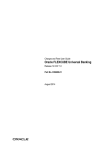



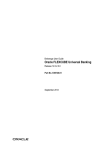

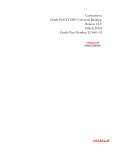

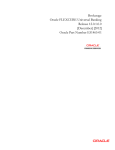
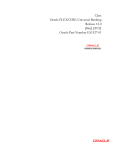
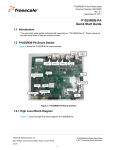
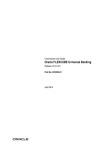


![[August] [2010] Oracle Part Number E51575-01](http://vs1.manualzilla.com/store/data/005654822_1-60fccbb787b73d73a8aa90efa0003782-150x150.png)
